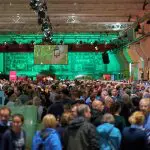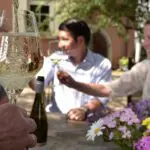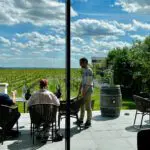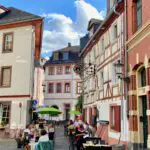Want to see one of Germany’s oldest and newest wineries in one go? Abbey Eberbach, the birthplace of the Cabinett wines and home to one of Europe’s most modern wineries offers both. Visiting offers a time warp that could hardly be more interesting…
And wine that makes glad the heart of man, and oil to make his face to shine, and bread which strengthens man’s heart. (104:15)
When in 1136 twelve cistercian monks coming from Burgundy founded Abbey Eberbach, probably none of them would have fathomed the incredible piece of wine history they started writing. Starting off from just a secluded plot of land in a small valley of the Taunus opening up onto the River Rhine (the region now being known as Rheingau) they had laid the foundations not only for a religious stronghold but also for a business in wine. And what business that would become: within little time the monks of Abbey Eberbach had started cultivating wine on the best terroirs in the region; they had created a network of 200 branches with posts in most important trading cities such as Mainz and Cologne; and set up their own flotilla of thirty boats to ship wines northwards on the River Rhine. In the centuries to come and together with competing abbeys and castles in the region, such as Johannisberg, Vollrads or Eibingen – now all grand cru wineries – Eberbach set the pace for Riesling production.
It was the monks of Eberbach who started maturing wines in the ‘cabinets’ of the Cabinett Cellar, or who built walls around their most precious vines for instance Domäne Steinberg – creating terroirs similar to the ‘clos’ in Burgundy and Champagne.
Business was never easy, the region being notoriously ravaged by conflicts and wars, but the Abbey always bounced back. Ironically it was the French – first revolutionary troups in 1792, then Napoleon – who almost put an end to winemaking in Rheingau. Abbeys got closed, and Church properties got confiscated, ending up in the hands of aristocrats and administrations with little experience in winemaking. Still, Rhine wines rose back to fame in the 19th century and were traded for a long period amongst the most expensive wines of world.
And what’s left today?The heritage of the Abbey Eberbach – both the historic buildings and it’s wine production is mostly in state hands, which in this case means good, caring hands. For wine lovers it’s a chance to step from the origins of wine production to to one of Europe’s most modern wine cellars.
The historic Cabinett Cellar – though out of operation – can be visited as part of an abbey tour. Production of wines has relocated closer towards the vineyards and can be visited, too.
Start visiting the well maintained and restored historic buildings of the Abbey, where you can see historic wine presses and the cabinett cellar. Taste and stock up wines in the Abbey’s shop before moving on about half a mile down the road to visit the cellars at Domäne Steinberg – now amongst Europe’s most modern wine production facilities. A tour will take you underground, as most of the production facilities are hidden up to 14 meters below the vines. Above ground the tasting room and the visitor terrace offer beautiful views over the wines of Domäne Steinberg, Rheingau and the River Rhine.
Admittedly at this point you might need a lot of imagination to figure medieval months working the vines – yet this is where it all began.
A visit to Abbey Eberbach is regularly part of our grand cru tour through Rheingau.













